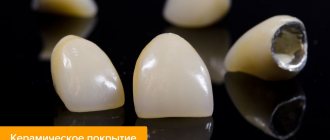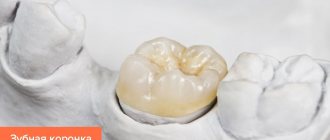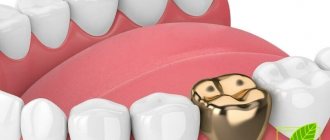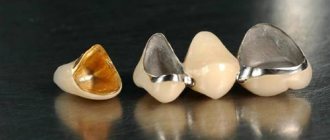Dental prosthetics allows a person to restore the functionality and aesthetic appearance of the dentition. Metal-ceramics is considered the best material for this. The disadvantage of this solution is the risk of chipping and damage. The likelihood of chipping increases if a person often eats solid foods: first, microcracks form on the crown, and only then chips.
Chips cannot be ignored, since if restoration measures are not carried out in a timely manner, the crown will collapse completely. You need to make an appointment with the dentist as soon as possible.
Description of material
A metal-ceramic crown is made from a metal alloy and then covered with porcelain. In this case, the frame can be made of several noble metals at the same time or simply of cobalt, nickel, chromium. It is these materials that provide the structure with the necessary strength, so the tooth and jaw as a whole can function normally. The ceramic layer is responsible for aesthetics.
Replacing teeth with ceramics is considered one of the most reliable and durable options. But, as a rule, they are the ones most often exposed to chips and various damages. Therefore, you need to know what to do if a piece of a metal-ceramic crown breaks off. The fact is that ignoring this problem can destroy it completely in a short time.
This is especially true for those people who do not follow medical recommendations and consume solid foods. Such abuse often violates the integrity of the tooth: first, microcracks form on it, and later chips appear.
CERAMICS OF DENTAL CROWNS CHIP - WHAT TO DO?
Patients often come to us with the problem of chipped ceramics. Sometimes these are chips of the ceramic lining of metal-ceramic structures, and sometimes it is the ceramic of crowns based on zirconium oxide that chips. Chips of ceramic veneers and inlays are also treated.
Many people ask the question: “Is it possible to glue a broken piece?” The fact is that ceramics chip not because of a lack of strength of the material, but because of the active work of the masticatory muscles. In other words, any chip is usually preceded by a prolonged increased chewing load, and as a result, an area of stress appears in the material.
“But I don’t eat anything tough,” the patient objects. That's right, you can eat exclusively soft food, but the ceramics will nevertheless chip.
Let's start with the fact that the human chewing muscles are the strongest muscles in the body, capable of developing a force of up to 300 kg/cm². Imagine that you have a new crown installed, and although you like everything, it seems that the tooth is a little in the way. The dentist says that you need to get used to the crown, and such sensations will pass. Indeed, soon you will stop feeling discomfort.
This occurs due to the fact that the crown of the tooth actually turns out to be slightly higher than necessary, but the chewing muscles and ligaments of the tooth soon adapt to it. However, the crown continues to overbite (this is called premature contact) and takes on increased chewing load. There is no uniform distribution, and the main load falls on the brand new tooth crown. In this case, areas of constant stress appear in the ceramic lining and, after some time, chipping occurs.
What happens if you glue the piece back? It is easy to guess that after a short time a repeat chip will occur in the same area. Even if a correction is made and the premature contact is ground off, the connection line between the piece of ceramic and the crown will no longer withstand normal chewing load. The same thing will happen if, when closing, the new crown of the tooth does not interfere, but you feel that the tooth seems to “catch” when moving the lower jaw sideways or forward.
“But where does the increased load come from if I don’t clench my teeth and don’t eat anything solid?” patients ask again. You may not clench your teeth during the day, but the work of the masticatory muscles continues at night, and it is much more active. This increased muscle activity is called bruxism and affects 99% of the population.
A new ceramic crown can provoke bruxism due to overbite (premature contacts). Teeth grinding is one of the ways stress is released and occurs completely uncontrollably. Bruxism can cause such phenomena as: increased tooth wear (also called pathological tooth wear), pain in the masticatory muscles, tension in the muscles of the head and neck, especially in the morning. Understanding what happens in your mouth during sleep, a gnathologist will be able to tell you why your teeth have worn down , or the enamel on your teeth has worn off, and also why the ceramics have chipped.
The second scenario that can occur if a new crown is installed incorrectly is a displacement of the lower jaw. The fact is that in most MOSCOW CLINICS, CROWNS are made without taking into account the individual shape of your own teeth. As a result, the bite is overestimated and the chewing muscles slightly shift the lower jaw. Premature contact is no longer felt, but remains. Displacement of the lower jaw leads to displacement of the structures of the temporomandibular joint, of which the lower jaw is also a part. After some time, the jaw begins to crunch, and pain appears in the joint. In this case, you simply need an urgent consultation with a gnathologist.
Gnathology allows you to evaluate the functioning of your masticatory apparatus, identify the causes and understand why ceramics chip, teeth wear out, or the lower jaw crunches and clicks. Treatment of abrasion, chips of ceramics and crunching of the lower jaw, as well as preliminary comprehensive diagnostics, are carried out using special equipment that allows you to calculate the individual parameters of the patient’s dental system for dental restoration.
If we return to the issue of chipping ceramics, then the most reliable and predictable result will be obtained by replacing the old structure with a new one, which will be manufactured after a functional analysis has been carried out.
Main causes of damage
A ceramic crown can become damaged for various reasons. But, as dental technicians note, the most common cases of chipping are as follows:
- A man has bruxism, and the dentist who performed the prosthetics did not ask about the disease.
- The patient does not comply with the operating instructions.
- The product may chip due to a foreign body that has entered the space between the tooth and the crown.
- When manufacturing the device, the master did not take into account the composition’s ability to thermally expand.
- There are too many dental units in the bridge, so it bears a heavy load of both external and internal nature.
- The shape of the prosthesis is incorrect or poorly made, so the pressure on it from the opposite jaw row is uneven.
- The technology during firing of the structure was violated.
- The preparation was not performed correctly, the taper of the crown is incomplete, which causes severe stress within the system.
- During the restoration, an excessively thick fixing cement mixture was used.
During the operation of the crown, a chip appeared
After the recovery procedure
Restoration of a metal-ceramic crown with damage of any complexity
Medical offers services for the restoration of dental crowns in a short time. We provide comprehensive treatment, dental prosthetics, and repairs at affordable prices. The individual approach and professionalism of the staff, the use of only high-quality materials and modern technologies allows you to achieve an ideal smile and the health of your teeth.
VTV managers will tell you about the cost of crown restoration and scheduling a visit to the clinic’s specialists in the feedback form on the website or by phone.
Modern methods of restoration
A chip in the ceramic mass does not look very attractive. The patient’s quality of life decreases and various complexes appear. Modern dentistry offers several ways to restore teeth; there are even options in which you can sharpen a metal-ceramic crown without removing it.
The most common restoration method is polishing. The procedure is performed for minor damage to the ceramic part of the tooth. The main disadvantage of this method is that the crown loses its original shape, so it is most often used if the chip is in an inconspicuous place.
One of the main advantages of polishing is accessibility, since the cost of such procedures is low. During the event, the doctor treats the damaged area with a special polishing compound using a rubber brush, and the gaps between the teeth with finishing plates.
Repairing a chip on a metal-ceramic crown involves completely replacing it. This option is the most expensive of all, but also the most reliable. If the structure was screwed in, then it is drilled out with a special drill and a suitable nozzle. If the crown was fixed with dental glue, then preliminary decementing is required: a softener is applied, which will bring the glue to a paste-like state.
After the structure has been cemented, the dentist makes a control impression, prepares the tooth, if necessary, and then performs processing. Next, the model is sent to the laboratory for the manufacture of a new product. The effectiveness of this method cannot be compared with any other correction option in terms of efficiency and effectiveness.
The next restoration is carried out only after the crown is removed, but it should immediately be noted that this option has many disadvantages, so doctors do not recommend using it. This is due to the fact that it is extremely difficult to maintain the integrity of a ceramic tooth if it is fixed with cement. Although there are patients who agree to this procedure because of the low cost and short repair time.
There are more progressive and gentle methods for restoring a chipped tooth that do not destroy ceramics. Such dental procedures involve the use of directional ultrasonic vibrations, as well as the supply of compressed air. But such procedures are carried out only in good clinics that are equipped with expensive devices.
Repairs can also be made directly in the oral cavity. As a rule, such restoration leaves virtually no traces behind. Modern composites are of very high quality; after spraying, the metal does not show through.
A significant disadvantage of the procedure: no doctor can guarantee that the crown will last a long time and will not fall off immediately. Such manipulations are somewhat reminiscent of ordinary fillings.
Recovery after removal
Restoring a ceramic prosthesis is quite difficult, and only a professional can do such work efficiently. The fact is that when removed, the crown may be damaged or completely destroyed, and it will be impossible to restore the product in order to glue it back. To carry out such events you will need tools and special devices:
- a device equipped with a tip that resembles a crochet hook;
- separator bolt;
- pneumatic hand tools;
- mechanical devices for removing the prosthesis from the mouth;
- spitting utensils;
- forceps.
The manipulations are carried out under local anesthesia, so the patient should not experience pain. Immediately after removal, the denture is sent to a special laboratory, where a dental technician will carefully examine the structure and restore the product. The entire recovery procedure usually lasts no longer than 3-5 hours.
It also happens
If a small chip has formed and the separated part is preserved, then it is simply glued to its original place using medical quick-drying glue. If the fragment is lost, then several ceramic layers are applied to the crown, thereby giving the tooth the required shape. After this, all that remains is to dry the prosthesis; this is done under the influence of high temperature in a special oven.
At the final stage, the technician grinds off excess fragments, grinds the crown and carries out final polishing. But this method is used extremely rarely, since the percentage of prosthesis removal without damage is extremely low. In addition, there is a high probability of injury to the gums and soft mucosal tissues. It is impossible to guarantee that such a design will last a long time, even if the work is done efficiently and professionally.
Oral repair
This option is most common among owners of metal-ceramic teeth. This is due to the fact that there is no need to remove the crowns; just open your mouth and the doctor will repair the damage on the spot. The procedure itself is performed in stages:
- Moisture is completely removed from the oral cavity. This is a prerequisite before any restorative procedures. The area where the chip formed is also thoroughly dried and then prepared with a diamond drill. This will make the tooth surface rougher, which will allow the composite to adhere to the ceramic more firmly and reliably.
- The surface is cleaned of any crumbs and diamond dust present on it. Next, the dentist impregnates the metal-ceramic crown and the area where there is damage with an acid mass for 1 minute. Modern clinics mainly use hydrofluoric acid for these purposes. After 60 seconds, the oral cavity is thoroughly rinsed under powerful water pressure and dried again.
- Then the doctor applies silane to the ceramic, which dries within a few seconds, and then treats the dental crown with a primer: this material enhances adhesion.
- After these steps are completed, the main work begins. Using a special composition, the required number of layers are applied to the chip site and the product is given the desired shape.
At the very end, the denture is treated with adhesive and then with a surface composite material. All that remains is to grind and polish the crown, and the procedure is considered complete.
Why is there no guarantee for the repair of chipped crowns?
- Metal-ceramic crowns and all-ceramic crowns were originally manufactured in a laboratory environment, where high temperatures and other technological features were used, which cannot be used for restoration in the mouth.
- The doctor can find out what caused the chipping of cermets or ceramics only after a thorough diagnosis, excluding cases where the patient remembers exactly that he was biting nuts, crackers or biting a fork. If a chip on the crown occurred due to malocclusion, in which the load on the teeth was distributed unevenly, then without correcting the bite, a chip may form in the same place again. If the cause of a chip on the crown is bruxism (excessive clenching and grinding of teeth), then the consequences in the form of chips can be repeated repeatedly.
- If the crown is old, then the best solution would be to replace it (the doctor will definitely tell you about this), but the patient has to go to a wedding tomorrow, sign a contract, etc., and today it is necessary “at least until tomorrow” to restore the appearance of the teeth.
Forecast of dental condition
It does not matter what technique was used to restore the metal-ceramic crown. It is impossible to predict exactly how long it will last. But you can determine the approximate service life based on several factors:
- Amount of damage. If the chip was large enough or there were several of them, then such dentures will collapse quite quickly, so it is best to initially replace the old structure with a new one.
- The basis. It is very important what the crown is made of: if it is metal, then the adhesion to the composite material will be several times lower than that of ceramic products.
- Malocclusion. This pathology can provoke a new breakdown almost immediately after restoration work.
- Non-compliance with operating rules and poor dental care.
- A bridge consists of a large number of dental units.
- A leaky connection causes the structure to quickly collapse.
As dentists note, the main cause of various damages is trauma and improper care of artificial teeth. If trouble does occur, restoration measures should be started immediately, otherwise the crown may completely collapse and a new product will be required.










